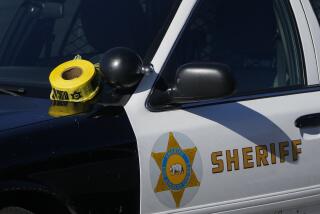Report Sheds Little Light on Payne Stewart Plane Crash
Offering little to better explain the mysterious plane crash 13 months ago that killed golfer Payne Stewart and five others, federal investigators on Tuesday confirmed long-held suspicions that the accident probably was caused by a loss of cabin pressurization.
National Transportation Safety Board investigators had said privately for months that the Learjet 35 apparently depressurized as it reached 39,000 feet after taking off from Orlando, Fla., on Oct. 25, 1999, on a planned flight to Texas.
This depressurization at high altitude apparently incapacitated Stewart, three other passengers and the two pilots on board, rendering them unconscious within seconds and probably dead within minutes.
The investigators say the twin-engine executive jet, apparently on autopilot, flew on for 1,400 more miles before running out of fuel and crashing into a muddy field near Mina, S.D.
But what the investigators still don’t say is why and how the plane decompressed--two questions that may never be answered.
“Because of the severe fragmentation of the wreckage, coupled with the lack of a flight data recorder, the NTSB was unable to determine what caused the depressurization,” Ted Lopatkiewicz, a spokesman for the agency, said Tuesday.
NTSB Chairman Jim Hall noted that the plane’s cockpit voice recorder recycled after 30 minutes. Since those aboard the plane apparently lost consciousness at least three hours before the crash, their last remarks had been erased.
Several depressurization scenarios have been suggested, but none was mentioned in the brief NTSB crash report released Tuesday.
Those possibilities included the failure of the valves that control the flow of air pumped by the engines into the cabin, failure of an internal pressure bulkhead and failure of the outflow valve that bleeds off excess air pressure.
Experts say that if the depressurization was sudden, the pilots would have had only a few seconds to grab the emergency oxygen masks on their headrests before lapsing into unconsciousness.
Stewart’s family and the families of fellow passengers and business associates Ivan Ardan, Bruce Borland and Robert Fraley have filed suit against the plane’s operator, SunJet Aviation Inc., and the plane’s owner, JetShares One Inc. The pilots of the plane were Michael Kling and Stephanie Bellegarrigue. The NTSB report included 11 recommendations urging the Federal Aviation Administration to come up with better pressurization systems and better procedures for dealing with pressurization failures.
More to Read
Sign up for Essential California
The most important California stories and recommendations in your inbox every morning.
You may occasionally receive promotional content from the Los Angeles Times.










